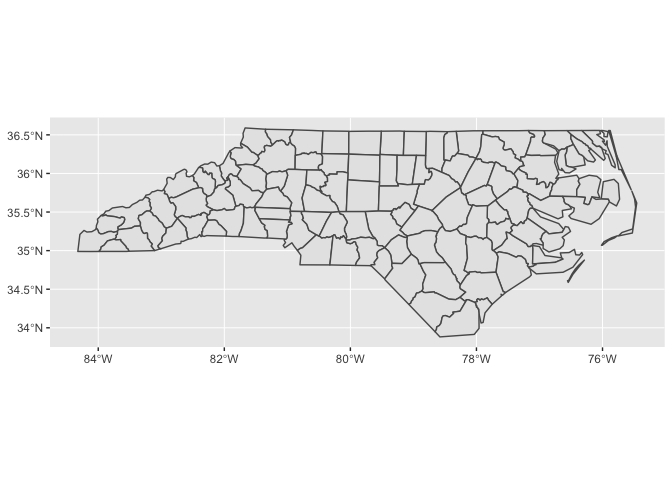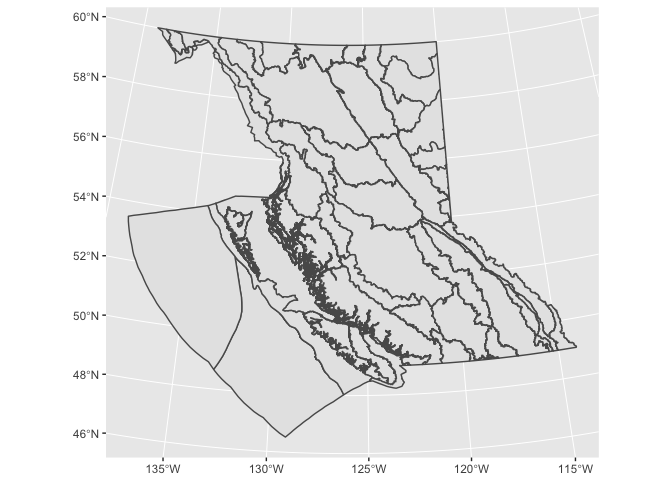I am on a Mac (2016 MBP 15" with 16GB memory) and am testing out the development version of ggplot2 with sf plotting support.
Overall I am loving it, but I am finding geom_sf to be very slow when plotting larger sf polygons objects. I think I've narrowed it down to the quartz graphics device, which is much slower than X11 on these large objects (however quartz produces nicer graphics than X11).
I would be happy to just use X11 but I do like having plots appear in the plot pane in RStudio, and I believe the RStudio Graphics Device uses quartz on Mac OS and I don't think there's a way to change that. So I'm not sure if this is a ggplot2/sf issue or if it's a Mac quartz issue... or possibly even an RStudio issue, but I thought I would post it here first to see if others are experiencing the same thing.
I also did the same comparison with sf's plot method - there is still a large difference between X11 and quartz, however overall it is faster than ggplot2::geom_sf.
Interestingly, quartz actually is faster than X11 on the smaller objects.
Reprex with timings; session_info at the end:
library(sf)
#> Linking to GEOS 3.6.1, GDAL 2.1.3, proj.4 4.9.3
library(ggplot2)
## Plotting a small polygons object with ggplot2::geom_sf
nc <- read_sf(system.file("gpkg/nc.gpkg", package = "sf"))
## Create ggplot2 object
nc_gg <- ggplot() + geom_sf(data = nc)
## geom_sf with X11
X11(type = "cairo")
system.time(print(nc_gg))

#> user system elapsed
#> 0.761 0.150 2.570
graphics.off()
## geom_sf with quartz
quartz()
system.time(print(nc_gg))

#> user system elapsed
#> 1.003 0.159 1.264
graphics.off()
## Plotting a large polygons object with ggplot::geom_sf
tmpzip <- tempfile(fileext = ".zip")
download.file("https://github.com/bcgov/bcmaps.rdata/blob/master/data-raw/ecoregions/ecoregions.zip?raw=true", destfile = tmpzip)
gdb_path <- unzip(tmpzip, exdir = tempdir())
ecoregions <- sf::read_sf(dirname(gdb_path[1]))
## Create ggplot2 object
ecoregions_gg <- ggplot() + geom_sf(data = ecoregions)
## geom_sf with X11
X11(type = "cairo")
system.time(print(ecoregions_gg))

#> user system elapsed
#> 2.948 0.363 3.854
graphics.off()
## geom_sf with quartz
quartz()
system.time(print(ecoregions_gg))

#> user system elapsed
#> 97.607 0.686 98.370
graphics.off()
## For comparison, here are timings using sf's plot method:
## Small object
## plot_sf with X11
X11(type = "cairo")
system.time(plot(st_geometry(nc)))

#> user system elapsed
#> 0.042 0.127 1.788
graphics.off()
## plot_sf with quartz
quartz()
system.time(plot(st_geometry(nc)))

#> user system elapsed
#> 0.210 0.062 0.271
graphics.off()
## Large object
## plot_sf with X11
X11(type = "cairo")
system.time(plot(st_geometry(ecoregions)))

#> user system elapsed
#> 1.078 0.628 8.068
graphics.off()
## plot_sf with quartz
quartz()
system.time(plot(st_geometry(ecoregions)))

#> user system elapsed
#> 44.291 0.393 44.665
graphics.off()
Session info
devtools::session_info()
#> Session info -------------------------------------------------------------
#> setting value
#> version R version 3.4.2 (2017-09-28)
#> system x86_64, darwin15.6.0
#> ui X11
#> language (EN)
#> collate en_CA.UTF-8
#> tz America/Vancouver
#> date 2017-11-28
#> Packages -----------------------------------------------------------------
#> package * version date source
#> assertthat 0.2.0 2017-04-11 CRAN (R 3.4.0)
#> backports 1.1.1 2017-09-25 CRAN (R 3.4.2)
#> base * 3.4.2 2017-10-04 local
#> bindr 0.1 2016-11-13 CRAN (R 3.4.0)
#> bindrcpp 0.2 2017-06-17 CRAN (R 3.4.0)
#> bitops 1.0-6 2013-08-17 CRAN (R 3.4.0)
#> class 7.3-14 2015-08-30 CRAN (R 3.4.2)
#> classInt 0.1-24 2017-04-16 CRAN (R 3.4.0)
#> colorspace 1.3-2 2016-12-14 CRAN (R 3.4.0)
#> compiler 3.4.2 2017-10-04 local
#> datasets * 3.4.2 2017-10-04 local
#> DBI 0.7 2017-06-18 CRAN (R 3.4.0)
#> devtools 1.13.4 2017-11-09 CRAN (R 3.4.2)
#> digest 0.6.12 2017-01-27 CRAN (R 3.4.0)
#> dplyr 0.7.4 2017-09-28 CRAN (R 3.4.2)
#> e1071 1.6-8 2017-02-02 CRAN (R 3.4.0)
#> evaluate 0.10.1 2017-06-24 CRAN (R 3.4.1)
#> ggplot2 * 2.2.1.9000 2017-11-17 Github (tidyverse/ggplot2@582acfe)
#> glue 1.2.0 2017-10-29 CRAN (R 3.4.2)
#> graphics * 3.4.2 2017-10-04 local
#> grDevices * 3.4.2 2017-10-04 local
#> grid 3.4.2 2017-10-04 local
#> gtable 0.2.0 2016-02-26 CRAN (R 3.4.0)
#> htmltools 0.3.6 2017-04-28 CRAN (R 3.4.0)
#> knitr 1.17 2017-08-10 CRAN (R 3.4.1)
#> lazyeval 0.2.1 2017-10-29 CRAN (R 3.4.2)
#> magrittr 1.5 2014-11-22 CRAN (R 3.4.0)
#> memoise 1.1.0 2017-04-21 CRAN (R 3.4.0)
#> methods * 3.4.2 2017-10-04 local
#> munsell 0.4.3 2016-02-13 CRAN (R 3.4.0)
#> pkgconfig 2.0.1 2017-03-21 CRAN (R 3.4.0)
#> plyr 1.8.4 2016-06-08 CRAN (R 3.4.0)
#> R6 2.2.2 2017-06-17 CRAN (R 3.4.0)
#> Rcpp 0.12.14 2017-11-23 CRAN (R 3.4.3)
#> RCurl 1.95-4.8 2016-03-01 CRAN (R 3.4.0)
#> rlang 0.1.4 2017-11-05 CRAN (R 3.4.2)
#> rmarkdown 1.8 2017-11-17 CRAN (R 3.4.2)
#> rprojroot 1.2 2017-01-16 CRAN (R 3.4.0)
#> scales 0.5.0.9000 2017-10-19 Github (hadley/scales@d767915)
#> sf * 0.5-5 2017-10-31 CRAN (R 3.4.2)
#> stats * 3.4.2 2017-10-04 local
#> stringi 1.1.6 2017-11-17 CRAN (R 3.4.2)
#> stringr 1.2.0 2017-02-18 CRAN (R 3.4.0)
#> tibble 1.3.4 2017-08-22 CRAN (R 3.4.1)
#> tools 3.4.2 2017-10-04 local
#> udunits2 0.13 2016-11-17 CRAN (R 3.4.0)
#> units 0.4-6 2017-08-27 CRAN (R 3.4.1)
#> utils * 3.4.2 2017-10-04 local
#> withr 2.1.0.9000 2017-11-17 Github (jimhester/withr@daf5a8c)
#> XML 3.98-1.9 2017-06-19 CRAN (R 3.4.1)
#> yaml 2.1.14 2016-11-12 CRAN (R 3.4.0)